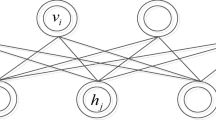Abstract
Understanding visual input as perceived by humans is a challenging task for machines. Today, most successful methods work by learning features from static images. Based on classical artificial neural networks, those methods are not adapted to process event streams as provided by the Dynamic Vision Sensor (DVS). Recently, an unsupervised learning rule to train Spiking Restricted Boltzmann Machines has been presented [9]. Relying on synaptic plasticity, it can learn features directly from event streams. In this paper, we extend this method by adding convolutions, lateral inhibitions and multiple layers. We evaluate our method on a self-recorded DVS dataset as well as the Poker-DVS dataset. Our results show that our convolutional method performs better and needs less parameters. It also achieves comparable results to previous event-based classification methods while learning features in an unsupervised fashion.
Access this chapter
Tax calculation will be finalised at checkout
Purchases are for personal use only
Similar content being viewed by others
References
Bengio, Y., Lee, D.H., Bornschein, J., Lin, Z.: Towards Biologically Plausible Deep Learning. arXiv preprint arXiv:1502.0415, p. 18 (2015)
Buesing, L., et al.: Neural dynamics as sampling: a model for stochastic computation in recurrent networks of spiking neurons. PLoS Comput. Biol. 7(11), e1002211 (2011)
Desjardins, G., et al.: Empirical evaluation of convolutional RBMs for vision. Technical report 1327, Département d’Informatique et de Recherche Opérationnelle, Université de Montréal (2008)
Diehl, P.U., et al.: Fast-classifying, high-accuracy spiking deep networks through weight and threshold balancing. In: International Joint Conference on Neural Networks (IJCNN), vol. 2015 (2015)
Griffiths, T.L., Kemp, C., Tenenbaum, J.B.: Bayesian models of cognition. In: Sun, R. (ed.) Cambridge Handbook of Computational Cognitive Modeling. Cambridge University Press, Cambridge (2008)
Lee, H., et al.: Convolutional deep belief networks for scalable unsupervised learning of hierarchical representations. In: International Conference on Machine Learning, pp. 609–616 (2009)
Lee, T.S., Mumford, D.: Hierarchical Bayesian inference in the visual cortex. J. Opt. Soc. Am. 20(7), 1434–1448 (2003)
Lichtsteiner, P., et al.: A 128 \(\times \) 128 120 dB 15us latency asynchronous temporal contrast vision sensor. IEEE J. Solid-state Circuits 43(2), 566–576 (2008)
Neftci, E., et al.: Event-driven contrastive divergence for spiking neuromorphic systems. Front. Neurosci. 7, 1–14 (2014)
Norouzi, M., Ranjbar, M., Mori, G.: Stacks of convolutional restricted boltzmann machines for shift-invariant feature learning. In: Conference on Computer Vision and Pattern Recognition (CVPR), pp. 2735–2742. IEEE (2009)
Petrovici, M.A.: Form Versus Function: Theory and Models for Neuronal Substrates. Springer, New York (2016)
Serrano-Gotarredona, T., et al.: Poker-DVS and MNIST-DVS: Their history, how they were made, and other details. Front. Neurosci. 9, 1–10 (2015)
Vasquez Tieck, J.C., et al.: Towards grasping with spiking neural networks for an anthropomorphic robot hand. In: International Conference on Artificial Neural Networks (ICANN) (2017)
Yang, T., Shadlen, M.N.: Probabilistic reasoning by neurons. Nature 447(7148), 1075–1080 (2007)
Acknowledgments
The research leading to these results has received funding from the European Union Horizon 2020 Programme under grant agreement n.720270 (Human Brain Project SGA1).
Author information
Authors and Affiliations
Corresponding author
Editor information
Editors and Affiliations
Rights and permissions
Copyright information
© 2017 Springer International Publishing AG
About this paper
Cite this paper
Kaiser, J., Zimmerer, D., Tieck, J.C.V., Ulbrich, S., Roennau, A., Dillmann, R. (2017). Spiking Convolutional Deep Belief Networks. In: Lintas, A., Rovetta, S., Verschure, P., Villa, A. (eds) Artificial Neural Networks and Machine Learning – ICANN 2017. ICANN 2017. Lecture Notes in Computer Science(), vol 10614. Springer, Cham. https://doi.org/10.1007/978-3-319-68612-7_1
Download citation
DOI: https://doi.org/10.1007/978-3-319-68612-7_1
Published:
Publisher Name: Springer, Cham
Print ISBN: 978-3-319-68611-0
Online ISBN: 978-3-319-68612-7
eBook Packages: Computer ScienceComputer Science (R0)




